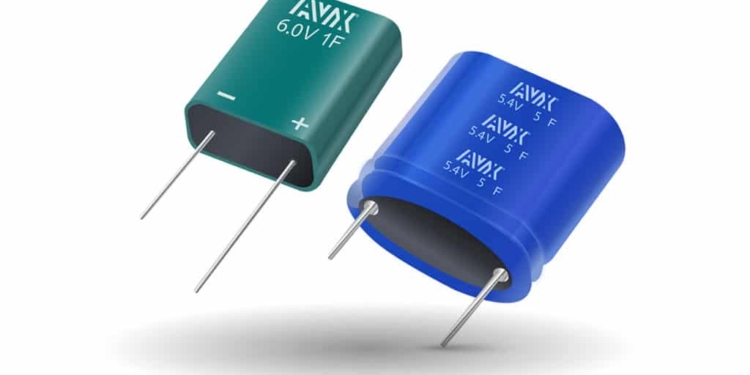Source: Avnet/Abacus engineers inside article
Written by Ekaterina Rachel, Product Manager, Passive. Instant power, always on, disposable, or not. Traditional battery technologies are being challenged by a relatively new kid on the block, the supercapacitor, and forcing developers across a range of battery-powered applications to examine just what and when power is needed for their system.
Where a battery’s chemistry stores power – usually involving harmful chemicals and toxic metals – capacitors store energy quasi-instantaneously through a combination of electrostatic and electrochemical storage of electrical energy. A supercapacitor has a solid or liquid electrolyte with positive and negative ions between its two electrodes (see below), which creates an ‘electrical double layer’ (accounting for the ‘EDLC’, as supercapacitors are otherwise known). Where a pair of electrons and positive ions or a pair of electric holes and negative ions form between the electrode and the electrolyte, capacitance is created.

A supercapacitor construction
Supercapacitors vs. batteries
Size is the main limiting factor for a supercapacitor; the surface area of the electrodes determines how much power can be stored. Whilst supercapacitors store considerably less power per gram than a battery, their storage capacity is often outweighed by their ability to be recharged over and over. In addition, minimal degradation gives them thousands of times more lifetime than a battery. In practice though, they are often connected in parallel with batteries. One of the most newsworthy applications for supercapacitor/battery combinations is regenerative braking whereby a kinetic energy recovery system (KERS) recaptures and reuses the high charging currents generated during deceleration and braking. This energy is stored in a reservoir – either a flywheel or batteries – for later use under acceleration.
Another key characteristic of supercapacitors is their capacity to charge and discharge quickly, which is why they are often used as an energy buffer or reservoir in electrical systems, large and small. As supercapacitors fill a short-term power need, by combining supercapacitor and battery technologies, battery stress can be reduced, extending the service life. Hence why supercapacitors are now found in everything from cars and forklifts, to wind turbines and wearables.
Applications for supercapacitors can be divided into three main areas:
- Energy harvesting – The supercapacitor sits between the harvester and the load to increase reliability and stability to the circuit or grid.
- Pulse power – The energy captured by the supercapacitor is released quickly to perform something energy-intensive, such as a lifting operation or acceleration.
- Power ‘hold-up’ or ‘last gasp’ – For a solid-state device for example – a supercapacitor provides enough energy to shut down the device in a controlled fashion after power loss. In a similar way, they can be used in larger systems to provide emergency power, e.g. to open a door in the event of power failure.
Sizing up supercaps
Some of the largest supercapacitors have high voltages (3.0V and more) and capacitances rated to several thousand farads, such as those used for regenerative braking and power assist for hybrid electric vehicles. At the other end of the scale are low profile devices that provide current of 2 to 3 A to meet the peak power demands of battery-powered consumer devices with current-limited energy sources.
When selecting a device, there are a few questions that specifiers should bear in mind:
- What is the temperature range of the application? (this is critical as a supercapacitor’s lifetime is a function of voltage and temperature. AVX’s internal testing suggests that life time doubles for every 10°C lower operating temperature, and again doubles for every 10% lower operating voltage.)
- Is energy harvesting, pulse power, or power hold-up required?
- What is the importance of equivalent series resistance (ESR) and leakage current (LC) on the design?
- What is the operating voltage of the application?
- What is your cost expectation?
For low profile applications, Murata’s DMT series of general-purpose supercapacitors cater to operating temperatures up to 85°C. With a low ESR of 130 mΩ, 4.2 constant voltage and capacitance range to 470 mF, Murata cites smart meters, door locks, power tools, motor applications and e-paper, as suitable use cases. Meanwhile, the high-power Murata 5.5V DMF series features low impedance and high capacitance in a small, slim package. With a temperature range of -40°to 70°C, the DMF series (below) is suitable for high-brightness LED flash, remote keyless entry, high-power audio and smart meters (especially in cold environments).

Murata’s DMF series supercapacitor
Whilst supercapacitor research focuses on improving electrolyte efficiency, exploring the use of graphene and improving their environmental performance using benign electrolytes, there is already a wide choice of high-performance supercapacitors available today.































